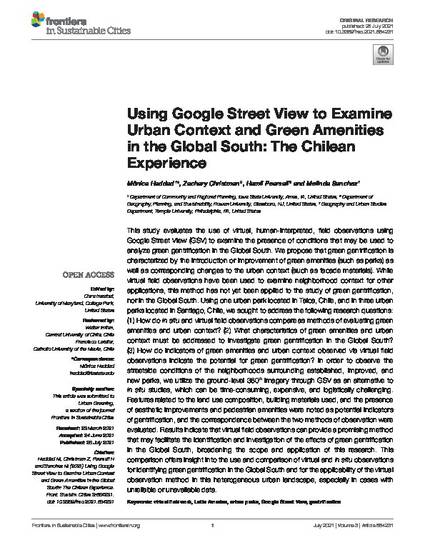
This study evaluates the use of virtual, human-interpreted, field observations using Google Street View (GSV) to examine the presence of conditions that may be used to analyze green gentrification in the Global South. We propose that green gentrification is characterized by the introduction or improvement of green amenities (such as parks) as well as corresponding changes to the urban context (such as facade materials). While virtual field observations have been used to examine neighborhood context for other applications, this method has not yet been applied to the study of green gentrification, nor in the Global South. Using one urban park located in Talca, Chile, and in three urban parks located in Santiago, Chile, we sought to address the following research questions: (1) How do in situ and virtual field observations compare as methods of evaluating green amenities and urban context? (2) What characteristics of green amenities and urban context must be addressed to investigate green gentrification in the Global South? (3) How do indicators of green amenities and urban context observed via virtual field observations indicate the potential for green gentrification? In order to observe the streetside conditions of the neighborhoods surrounding established, improved, and new parks, we utilize the ground-level 360° imagery through GSV as an alternative to in situ studies, which can be time-consuming, expensive, and logistically challenging. Features related to the land use composition, building materials used, and the presence of aesthetic improvements and pedestrian amenities were noted as potential indicators of gentrification, and the correspondence between the two methods of observation were evaluated. Results indicate that virtual field observations can provide a promising method that may facilitate the identification and investigation of the effects of green gentrification in the Global South, broadening the scope and application of this research. This comparison offers insight into the use and comparison of virtual and in situ observations for identifying green gentrification in the Global South and for the applicability of the virtual observation method in this heterogeneous urban landscape, especially in cases with unreliable or unavailable data.
Available at: http://works.bepress.com/monica-haddad/18/

This article is published as Haddad, M., Christman, Z., Pearsall, H., Sanchez, M., Using Google Street View to Examine Urban Context and Green Amenities in the Global South: The Chilean Experience. Frontiers in Sustainable Cities. 3(July 2021); Article 684231. Doi: 10.3389/frsc.2021.684231